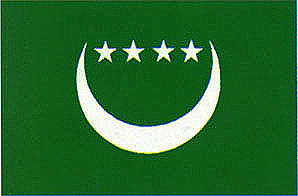
Comoros


Formal Name
Comoros,
independent state comprising a group of islands located at the northern entrance of the Mozambique Channel, between the African mainland and the island of Madagascar. Officially called the Federal Islamic Republic of the Comoros, the archipelago includes four major islands: Grande Comore (Njazidja), Mohéli (Mwali), Anjouan (Nzwani), and Mayotte. Sovereignty of Mayotte is claimed by the government of the republic; the island, however, remains a dependency of France. The republic (including Mayotte) has an area of 2236 sq km (863 sq mi).Land and Population
The Comoro Islands are of volcanic origin and are mountainous. The highest peak, Karthala (2361 m/7746 ft) on Grande Comore, is an active volcano. The islands have a tropical climate with a rainy season lasting from November to April and a cooler dry season prevailing the rest of the year. Forests cover only about 16 percent of the area and yield a modest amount of hardwood timber, mostly on Grande Comore.
The islands have an ethnically diverse population, including people of Arab, black African, and Malagasy descent. The largest group, the Antalote, is of mixed origin. French and Arabic are the official languages; the national language is Comorian, or Shaafi Islam, a blend of Swahili and Arabic. Islam is the most important religion on all the islands except Mayotte, where Christianity predominates. The estimated 1995 population is 653,000; the average population density is 292 persons per sq km (757 per sq mi). The principal towns are Moroni (population 1988 estimate, 22,000), the capital, on Grande Comore; Mutsamudu (14,000), on Anjouan; and Fomboni (7000), on Mohéli.
Economy
The economy of the Comoros is almost completely dominated by agriculture and fishing. Cassava, sweet potatoes, and rice are grown as food crops, but much of the islands' food is imported. Vanilla, ylang-ylang (a fragrance), cloves, and copra are grown for export. The basic unit of currency is the Comoros franc, which consists of 100 centimes (584.53 francs equal U.S.$1; 1994).
Government
Under the 1992 constitution, the head of state is a president elected by universal suffrage to a five-year term. The legislature consists of the Federal Assembly, with 42 members elected to four-year terms, and the Senate, with 15 members chosen by the electoral college to six-year terms. The prime minister, who heads the government, represents the majority party in parliament.
History
During the Middle Ages the islands were invaded by Arabs, and sultanates were established. The first European visited in the 16th century. In 1843 the ruler of Mayotte ceded his island to France. The other three islands became French protectorates in 1886. Declared a colony in 1912, the Comoros were joined, for administrative purposes, with Madagascar. The islands became an overseas territory of France in 1947. In 1974 three islands voted for independence, but Mayotte elected to remain under French rule. In the following year the Comoros unilaterally declared independence, claiming Mayotte as part of its territory. When the United Nations accepted Comoros for membership in 1975, it declared Mayotte a part of the country. However, the island remains a territorial collectivity of France and is governed by a prefect appointed by the French government. A referendum on the future of the island was postponed indefinitely in 1984.